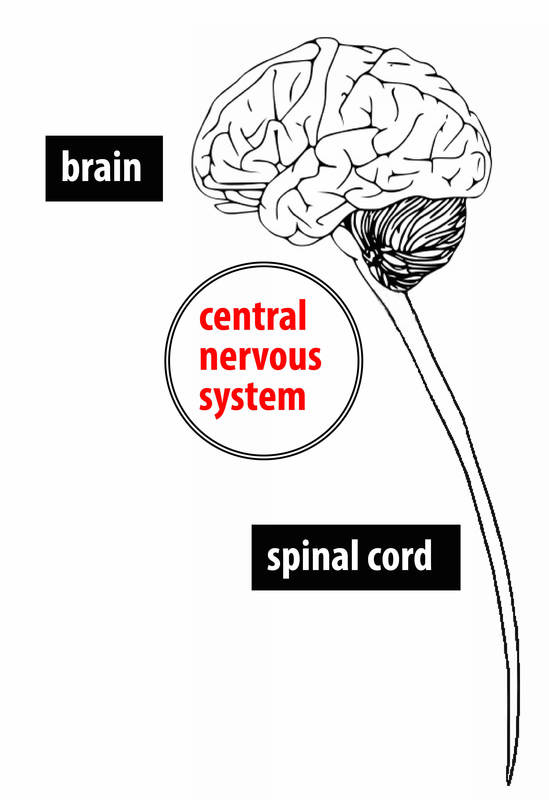- Describe the central nervous system
- Describe the structure and function of a neuron
- Describe how neurons communicate with each other
- Understand how neurotransmitters work and how drugs affect neurotransmitter systems
Understanding the nervous system is vital to understanding psychology in general. It is through the nervous system that we experience pleasure and pain, feel emotions, learn and use language, and plan goals, just to name a few examples.
The nervous system can be thought of as the body’s communication network that consists of all nerve cells. The nervous system can be divided into two major subdivisions: the central nervous system and the peripheral nervous system, shown in Figure 1. The central nervous system is comprised of the brain and spinal cord; the peripheral nervous system connects the central nervous system to the rest of the body (we’ll learn more about this later).

Figure 1. The nervous system is divided into two major parts: (a) the Central Nervous System and (b) the Peripheral Nervous System.
The Central Nervous System
the central nervous system
The central nervous system, or CNS for short, is the portion of the nervous system that is encased in bone (the brain is protected by the skull and the spinal cord is protected by the spinal column). It is referred to as “central” because it is the brain and spinal cord that are primarily responsible for processing information through our senses (touching a hot stove or seeing a rainbow, for example) and sending signals to the peripheral nervous system for action. It communicates largely by sending electrical signals through individual nerve cells that make up the fundamental building blocks of the nervous system, called neurons.

The Brain
The brain is a remarkably complex organ comprised of billions of interconnected neurons and glia. It is a bilateral, or two-sided, structure that can be separated into distinct lobes. Each lobe is loosely associated with certain types of functions, but, ultimately, all of the areas of the brain interact with one another to provide the foundation for our thoughts and behaviors.
The central nervous system is composed of what’s called grey matter and white matter—though both look the color tan in the brain, certain parts look more grey or white in brain scans or in preserved autopsies. Gray matter consists mostly of the main nucleus of the neurons. Gray matter is concentrated close to the interior of the spine in the spinal cord and around the exterior of the brain, though there are pockets of dense gray matter within the brain called nuclei. White matter consists of the surrounding sections that include the long axons of the neurons and more glial cells, which provide physical and metabolic support to neurons, including neuronal insulation and communication, and nutrient and waste transport. Glial cells vastly outnumber neurons.[1]
The Spinal Cord
The spinal cord is what connects the brain to the outside world. Because of it, the brain can function. The spinal cord is like a relay station, but a very smart one. It not only routes messages to and from the brain, but it also has its own system of automatic processes, called reflexes.
The spinal cord is functionally organized into 30 segments, corresponding with the vertebrae. Each segment is connected to a specific part of the body through the peripheral nervous system. Nerves branch out from the spine at each vertebra. Sensory nerves bring messages in; motor nerves send messages out to the muscles and organs. Messages travel to and from the brain through every segment. The top of the spinal cord is a bundle of nerves that merges with the brain stem, where the basic processes of life are controlled, such as breathing and digestion. In the opposite direction, the spinal cord ends just below the ribs—contrary to what we might expect, it does not extend all the way to the base of the spine.
The spinal cord is protected by bony vertebrae and cushioned in cerebrospinal fluid, but injuries still occur. When the spinal cord is damaged in a particular segment, all lower segments are cut off from the brain, causing paralysis. Therefore, the lower on the spine damage is, the fewer functions an injured individual will lose.
Some sensory messages are immediately acted on by the spinal cord, without any input from the brain, such as the withdrawal from a hot object. When a sensory message meets certain parameters, the spinal cord initiates an automatic reflex. The signal passes from the sensory nerve to a simple processing center, which initiates a motor command. As matters of survival, the spinal reflexes allow the body to react extraordinarily fast.
- Mercadante AA, Tadi P. Neuroanatomy, Gray Matter. [Updated 2022 Jul 25]. In: StatPearls [Internet]. Treasure Island (FL): StatPearls Publishing; 2022 Jan-. Available from: https://www.ncbi.nlm.nih.gov/books/NBK553239/ ↵